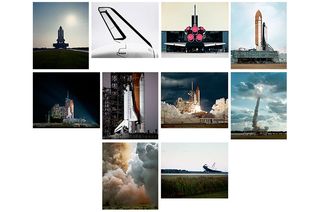Crowdfunded Photo Book Focuses on 'First Fleet' of NASA Space Shuttles

A photographer's long-forgotten, seldom seen images of NASA's first space shuttles are now set for publication, 30 years after they were captured.
"First Fleet: NASA's Space Shuttle Program 1981-1986," a collection of John Chakeres' photographs, will be released by Daylight Books in the fall of 2018, pending the outcome of a Kickstarter crowdfunding campaign nearing its end.
In 1981, Chakeres embarked on a project to document the now-retired fleet of winged orbiters, just as NASA prepared to launch its first space shuttle mission. [NASA's Space Shuttle - From Top to Bottom (Infographic)]
"I wanted to create images that were majestic, symbolic, and gave the viewer a sense of what was required to fly such a complex piece of technology. The idea was to do more of a portrait of the space shuttle," Chakeres writes of the project on Kickstarter. "The fact the space shuttle was the most complex machine ever created compelled me to photograph it."
"The space shuttle, in one sense, was a piece of sculpture to me," he said. "I was intrigued by how its design created a unique looking vehicle, and its final form was determined by its function."
Chakeres, who by 1981 had already published two books of his landscape and art photography, followed the space shuttles and NASA's launch preparations at the Kennedy Space Center in Florida over the course of the fleet's first 24 missions. The project grew out of a life-long fascination with human spaceflight — which is why what happened on the 25th space shuttle mission made Chakeres step away from photographing the shuttle.
"It ended with the Challenger accident in 1986," Chakeres explains. "It was hard to continue the work after witnessing this accident, and I decided to set the project aside."
Get the Space.com Newsletter
Breaking space news, the latest updates on rocket launches, skywatching events and more!
Chakeres' film negatives remained in storage, unseen and never printed until 2013, two years after the 135th and final space shuttle mission. Friends and colleagues encouraged him to take a fresh look at the photos he took more than a quarter century earlier. Four years ago, he began scanning the film, rediscovering the images.
"I began to think about what compelled me to make them," Chakeres said.
Chakeres says he was drawn to NASA's activities by how each of the pre-shuttle missions seemed to set a new first, a trait that continued as the orbiters took flight. The space shuttles were the first to service satellites in orbit, the first to launch American women and minorities into space, and the first to fly as a group serving a common purpose.
During the burgeoning years of the space shuttle program, NASA had four operational orbiters: Columbia, Challenger, Discovery, and Atlantis. (Endeavour would later be added in the wake of the loss of Challenger.) "Those four vehicles comprised the first fleet of manned spacecraft, hence the title for the book," Chakeres writes on Kickstarter.
Chakeres' photos captured the four orbiters rising from the launch pad, landing from space and between the missions being moved and prepared for flight.

"First Fleet" will present about 70 of Chakeres' photos in a 12 by 12-inch (30.5 by 30.5 centimeter) coffee-table format book. Former shuttle astronaut Leland Melvin will write the foreword, with photography curator W.M. Hunt penning the introduction. "First Fleet" will number 144 pages.
In addition to three earlier books (including "Random New York: An Unscripted Walk, 2008"), Chakeres' photographs have been included in numerous exhibitions and in other publications and are in a number of permanent collections, including the Museum of Modern Art in New York City. He has taught photography, printmaking and digital imaging at Ohio University, Columbus College of Art and Design and Columbus State Community College in Ohio.
Chakeres' Kickstarter awards supporters with copies of the book, as well as a "First Fleet" mission patch, photo cards and limited edition prints. The $16,000 campaign ends on Sunday (Dec. 3).
For his part, Chakeres considers "First Fleet" as his way of giving back to the space program, which had a real impact on his life.
"'First Fleet' is my way of paying homage to all of the men and women who built and flew the space shuttle, and how they inspired me to live a creative life," Chakeres states.
For more details or to back the campaign, see "First Fleet: NASA's Space Shuttle Program 1981-1986" on Kickstarter: http://kck.st/2zZ71rZ
Follow collectSPACE.com on Facebook and on Twitter at @collectSPACE. Copyright 2017 collectSPACE.com. All rights reserved.
Join our Space Forums to keep talking space on the latest missions, night sky and more! And if you have a news tip, correction or comment, let us know at: community@space.com.

Robert Pearlman is a space historian, journalist and the founder and editor of collectSPACE.com, an online publication and community devoted to space history with a particular focus on how and where space exploration intersects with pop culture. Pearlman is also a contributing writer for Space.com and co-author of "Space Stations: The Art, Science, and Reality of Working in Space” published by Smithsonian Books in 2018. He previously developed online content for the National Space Society and Apollo 11 moonwalker Buzz Aldrin, helped establish the space tourism company Space Adventures and currently serves on the History Committee of the American Astronautical Society, the advisory committee for The Mars Generation and leadership board of For All Moonkind. In 2009, he was inducted into the U.S. Space Camp Hall of Fame in Huntsville, Alabama. In 2021, he was honored by the American Astronautical Society with the Ordway Award for Sustained Excellence in Spaceflight History.

